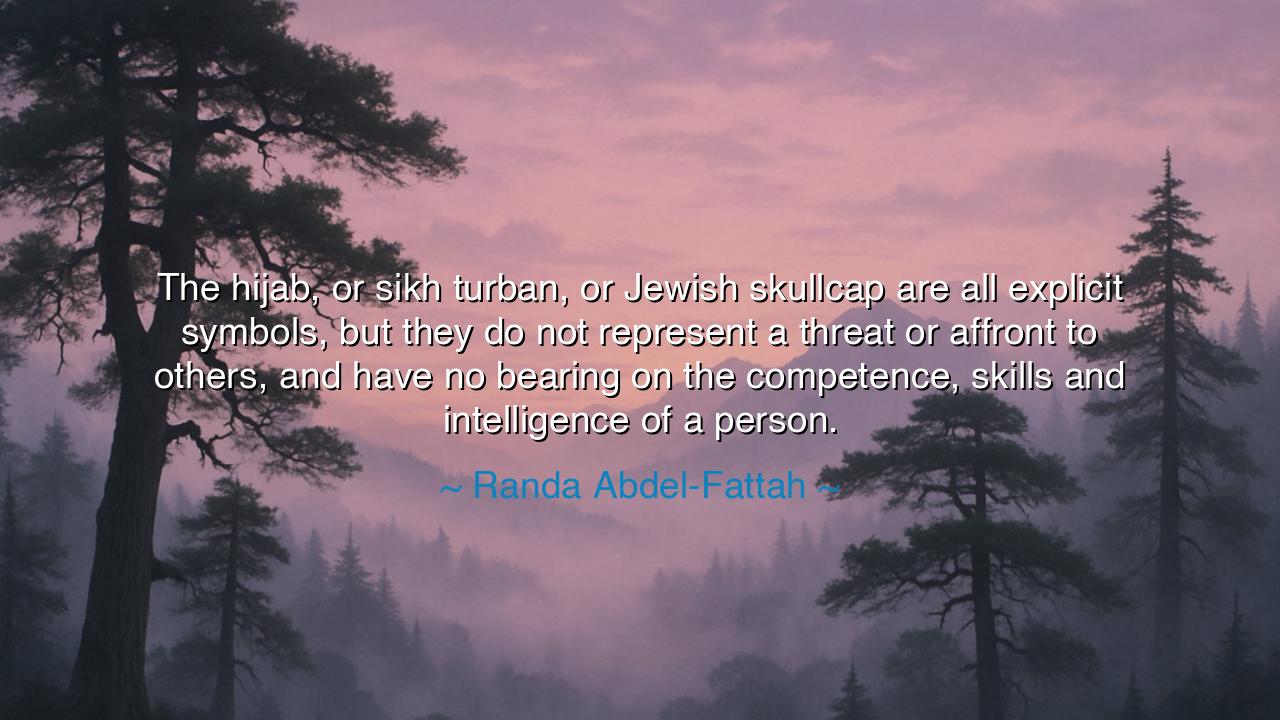
The hijab, or sikh turban, or Jewish skullcap are all explicit
The hijab, or sikh turban, or Jewish skullcap are all explicit symbols, but they do not represent a threat or affront to others, and have no bearing on the competence, skills and intelligence of a person.






When Randa Abdel-Fattah wrote, “The hijab, or Sikh turban, or Jewish skullcap are all explicit symbols, but they do not represent a threat or affront to others, and have no bearing on the competence, skills and intelligence of a person,” she was speaking not merely of garments, but of the eternal struggle between appearance and essence, between how we are seen and who we truly are. Her words rise as a defense of human dignity against the blindness of prejudice — a call to remember that the sacred spark within each soul is not woven into fabric, nor bound to custom, nor defined by the eye of another. What she declares is an ancient truth, as old as civilization itself: that identity is sacred, and its expression is not a threat but a form of grace.
Born of her own experiences as a Muslim woman in the modern world, Abdel-Fattah understood the weight of the gaze that misunderstands. The hijab, like the turban or skullcap, has too often been mistaken for separation rather than expression — as though a symbol of faith were a wall rather than a window. But what she teaches us is that these symbols, when seen through the eyes of understanding, are not barriers; they are bridges between the divine and the human. They are the outward signs of inward conviction, worn by those who choose to remember their Creator in the rhythm of their daily lives. To condemn such symbols is not merely to misjudge a person — it is to deny the profound beauty of diversity that the earth itself celebrates.
Throughout history, humanity has always sought to clothe the spirit in visible signs. The robes of monks, the armor of samurai, the ashes upon the forehead of the penitent, all were marks of devotion, humility, or purpose. Yet, time and again, the ignorant have mistaken difference for danger. In medieval Spain, Jews and Muslims were forced to hide their symbols of faith; in colonial India, Sikhs were mocked for their turbans; in modern cities, Muslim women are told to unveil to be “free.” But the wise see through such folly. They know that clothing does not make a person inferior or superior — it is only the garment of the soul’s story, and every story deserves to be told.
Consider the tale of Malala Yousafzai, who wore her school uniform and her scarf with pride while standing against tyranny. Her hijab was not a cage; it was her crown. It symbolized her strength and her right to knowledge. When others saw oppression, she saw purpose — a reminder of who she was and what she believed. And when violence tried to silence her, it was her spirit, not her appearance, that spoke to the world. Her courage illuminated Abdel-Fattah’s truth: that competence, intelligence, and skill are born not from how we look, but from how we live.
There is power in what Abdel-Fattah calls us to remember — that symbols are not threats when they are worn with love, nor should faith be feared when it manifests in peace. A person’s worth cannot be measured by the fabric on their head any more than by the color of their skin or the language of their prayer. The true measure lies in their deeds, their compassion, their integrity. If one’s heart is generous and one’s mind is keen, then no symbol can diminish their light. To judge by appearance is to see only the surface of the ocean, while the depths — rich, vast, and living — remain unseen.
Her words are also a lesson in humility. We are all clothed in different traditions, carrying the weight of histories our ancestors wove into us. The hijab, the turban, the skullcap, each speaks of a journey — a people’s covenant with the divine, a reminder of belonging. To honor these symbols is to honor the human story itself, which is the story of many paths leading to one truth. The wise do not fear difference; they learn from it. They see that every act of devotion, though shaped by culture and time, points toward the same eternal source.
And so, dear listener, remember this: judge not by the outer sign, but by the inner flame. Let no veil, no turban, no skullcap obscure your vision of another’s humanity. When you encounter one whose attire is foreign to you, bow in respect — for you are standing before a fellow traveler in the vast pilgrimage of life. As Randa Abdel-Fattah teaches, the earth is home to all its children, and each has the right to wear their faith, their culture, and their dreams upon their being. When we learn to see the divine in diversity, then and only then will the world be truly intelligent — not with the cleverness of the mind, but with the wisdom of the heart.






AAdministratorAdministrator
Welcome, honored guests. Please leave a comment, we will respond soon